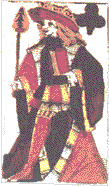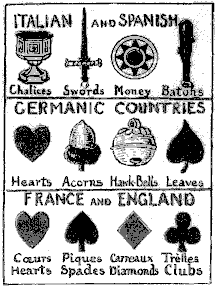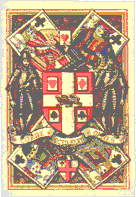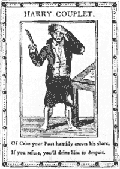Collecting English Playing Cards & Games
The History of English Playing Cards dates probably from the mid 15th century, the first documentary evidence of their existence in this country occurring in an Act of Parliament which prohibited the import of foreign cards.

with
Donald Welsh
Founder of the English Playing Card Society
THE HISTORY OF ENGLISH PLAYING CARDS dates probably from the mid 15th century, the first documentary evidence of their existence in this country occurring in an Act of Parliament [3 Edw. IV. c.4] which, upon the petition of domestic card makers, prohibited the import of foreign cards. Some 20 years later, we learn from the Paston Letters that the family played cards on a festive occasion. Court accounts during the reign of Henry VII refer to the Queen’s debt at cards. But still we have no direct evidence of what the cards themselves looked like.



It seems reasonable to suppose that they resembled the earliest designs which we know to have come from France (see illustration right), which have subsequently evolved into the familiar, modern English pack. These were made by Jehan Henault in Antwerp in 1543. A similar set of designs by Pierre Marechal of Rouen, made some 20 years later, is also known. Other early cards exist in museums and libraries.
 In fact, these designs most probably originated in the city of Rouen, where cards were made and exported to many parts of Europe. French suit marks were employed, but when the English came to name the suits we find Spanish or Italian influences which leave us no clearer on the matter… the mongrel nomenclature is highlighted by the popularity in the past of such imported games as Ombre and Primero.
In fact, these designs most probably originated in the city of Rouen, where cards were made and exported to many parts of Europe. French suit marks were employed, but when the English came to name the suits we find Spanish or Italian influences which leave us no clearer on the matter… the mongrel nomenclature is highlighted by the popularity in the past of such imported games as Ombre and Primero.
By their nature and use, cards are flimsy and perishable. If players do not wear them out, then mice will eat them. It is hardly surprising that the total number of English cards surviving before 1590 cannot exceed a dozen or so.
In 1590 an educational pack of cards was made by William Bowes illustrating county maps of England and Wales. Cards from about 1630 were found in the walls of Trinity College Cambridge, early in the 20th century.
In the mid 17th century the Puritan regime was doubtless responsible for the destruction of thousands of packs, gambling being regarded by half the country as frivolous and immoral, although the manufacture of cards was permitted. Thousands of packs must also have been destroyed during the great plague of London (1664-1666) and in the Great Fire of London (September 1666).
It is not until the restoration of Charles II that we find any sort of order and continuity in the history of the publication of playing cards, or, indeed, surviving examples of full packs.


It is therefore with this period that collectors begin to feel involved, although 17th century cards are very rare. The standard cards of the period, that is to say those traditionally used in play, are almost the most elusive of all, probably having been used to the point of disintegration and then thrown away. But by this time card makers had discovered new markets and uses for cards presented in novel form and issued many pictorial packs with the purpose of entertainment, education or propaganda of one kind or another. (Illustration to right: Heraldry card from Arms of the English Peers pack, 1686 / Card from 17th century English Proverbs pack.)
During the early 17th century a group of manufacturers banded together in London and with the King's support formed the Worshipful Company of Makers of Playing Cards in 1628. The King was desperate to raise money to continue fighting his wars and so, in exchange for tax revenues, he granted charters of incorporation to a number of trade guilds. Sums of money were paid for each concession and dues were yielded upon each year's trading.

The intention was to prevent the entry of foreign cards and to control and supervise manufacture within the London area. The Worshipful Company collected the tax on each pack sold and this was paid to the King. The revenue collected equated to the amount lost from the banning of imported cards, and at the same time the cards were no more expensive than they had been during the previous years.
After 1712 each pack had to be stamped or marked with the maker's name. As a result the appointed Commissioner for Stamp Duties chose the Ace of Spades to receive the mark and it remains so to the present day, although the actual duty was abolished in August 1960 as it had become uneconomical.
Before 1880 playing cards had no numbers in the corners. This had always created a problem when trying to fan out the cards. Also, the court cards were single-ended, full figures, so an opponent might notice the presence of a royalty in hand if it was to be placed right-way-up.
UNTIL VICTORIAN TIMES in England the backs of playing cards were plain, but eventually designs had to be printed on the reverse to avoid card sharps with a keen eye from recognising a card from the soiling or dirt marks on the back. Wear and tear during play resulted in the square corners becoming scuffed and rounded, and so round corners became standard.

Finally, the 53rd card in the pack was introduced at the end of the 19th century by the Mississippi gamblers on the river boats in America, and the pack evolved into the pack of cards that we take for granted today.
Cards of the past all belong to and evoke their period, whether it be a matter of style, fashion or customs. They belong to a cheerful, gregarious, competitive world, and provide the collector, by their associations, with an unusually vivid view of history, nonetheless interesting for being from the sidelines.
There is a magic in games… from those created in the imagination, such as hide and seek, to those using pieces of paper, sticks or sophisticated manufactured items. Some games recreate the thrill of sporting activities, whilst others give a sense of creativity. A few can even cause anger and frustration. Things have indeed come very far with regard to games since the invention of the internet. Just about every imaginable game can now be played online from card games to bingo.

Children's card games have been somewhat neglected in the past. They are distinct from ordinary playing cards, with their most obvious difference being the lack of any court cards or suit marks. Instead game cards are either numbered, lettered or grouped in some other way.


Children's card games used to be produced to very high quality, both in the materials used and the design and printing. Economic circumstances change, and children's card games today vary in quality and educational value.
Cards specifically designed for the amusement and education of children did not appear until the second half of the 18th century. Those produced at this time tended to have pictorial themes rather than the numerical format we are familiar with today.
A HUGE VARIETY of games has been devised over the years, the best known of which are Happy Families or Quartet games which involve completing sets of cards and declaring these to win the game. However, cards have also been used to tell fairy tales, ask and answer questions, illustrate nature, animals, places, to teach foreign languages, to foster early learning with numbers, spelling, currency, telling the time, and so on.
Learning the ideals of good behaviour came to be regarded as important as the three Rs: the precepts were often found as proverbs or morals on cards, just as they were reproduced in the handwriting copy-books of the day and preached from the pulpit.
See also: Animal Grab • Belisha • Black Peter • British Towns • Cartes Questions-Devinettes • Change for a Shilling • Counties of England • Cromy • Card Games • Dartex • Editorial Gráfica Flores • El Negrito Pedro • El Reloj Card Game • Famous Five • Golden Egg Game • Gnav • Happy Families • Jack-of-all-Trades • Hijitus • Hee Trading Co • Illustrated Proverbs • Jaques' Games • Jaques' Happy Families • Jewish Quartet Game • Kay Snap • Kingdoms of Europe • London Post • Hee Trading Co, Malaysia • Mexican Lottery Game • Noddy Happy Families • Pekka-Peli • Pepys Games • Peruvian Animals Quartet • Proverbs & Maxims • Reshuffle • Snip Snap • Tower Press • Vic Joc de Cartes • Walt Disney • Wild Flower Sevens • Woodland Old Maid • Woodland Snap • Zoo Comics

Related Articles

OXO Faces of the Millennium Dinner
Twentieth-century personalities promoting a millennium dinner at the Oxo Tower in London.

Kids Fun Box playing cards
Colourful cards for children with four non-standard suits connected with the natural world.

Tangle Foot Ale
Badger Brewery Tangle Foot strong ale advertising pack.

Scientific Whist
“Scientific Whist” : standard cards with instructions for play on the faces by Chas Goodall & Son, 1...

Agent Provocateur
Branded lingerie collection in a pack of pin-up playing cards.

Nimbus playing cards
Mike Steer’s weather-themed pack with suits in four colours and backs for cardistry.

Agatha Christie and Playing Cards revisited
Agatha Christie uses card-play as a primary focus of a story, and as a way of creating plots and mot...

The Decadent Deck
Studies in the eroticism of the female body by Inge Clayton.

Historic Shakespeare
“Historic Shakespeare” playing cards featuring Shakespearean characters by Chas Goodall & Son.

Copechat Paramount Sorting System
Preserving the past: a specimen deck showcasing edge-notched cards and their ingenious sorting syste...

Heartsette by Herbert Fitch & Co, 1893
A glimpse into a busy print and design office in late Victorian London.

Rap Rummy
Rap Rummy made by Parker Brothers in 1926, only 4 years after the discovery of King Tutankhamen’s to...

Batman® playing cards
Batman playing cards published by InterCol of London 1989.

Can You Believe Your Eyes?
“Can You Believe Your Eyes?” playing cards featuring visual illusions & other oddities.

Pastime Playing Cards for the Blind
The “Pastime” Playing Cards for the Blind manufactured by Goodall & Son Limd., c.1910.

The European Interchanges Quartets
A card game based around motorway intersections from European countries.
Most Popular
Our top articles from the past 28 days

